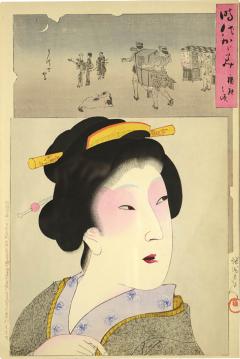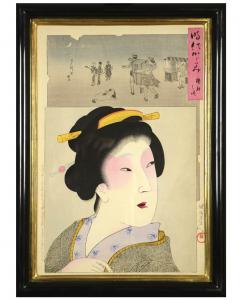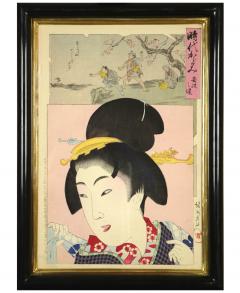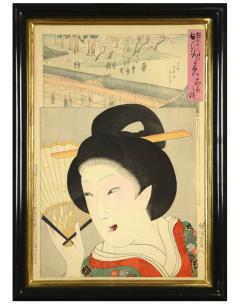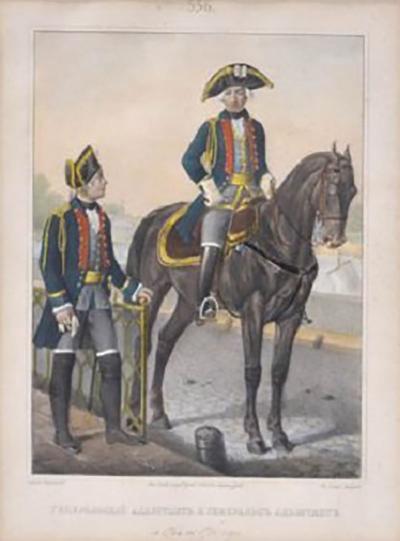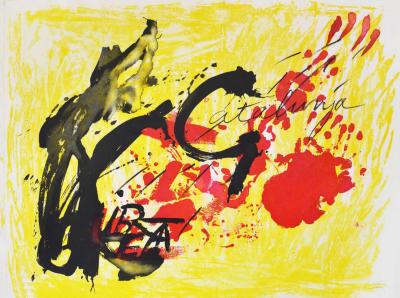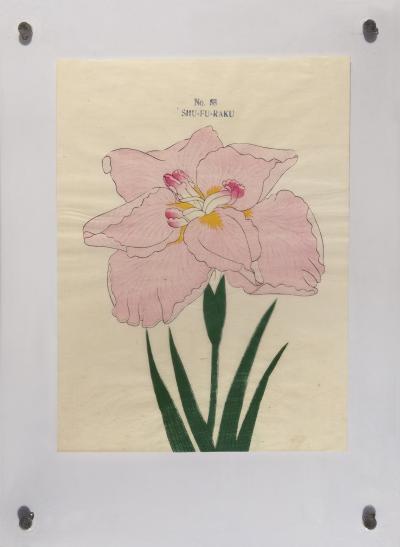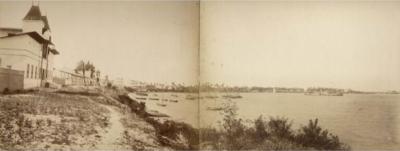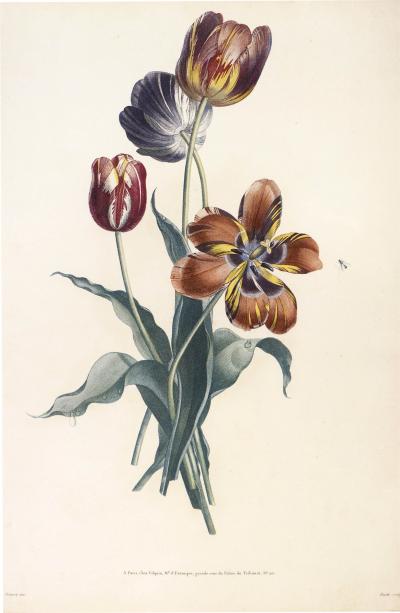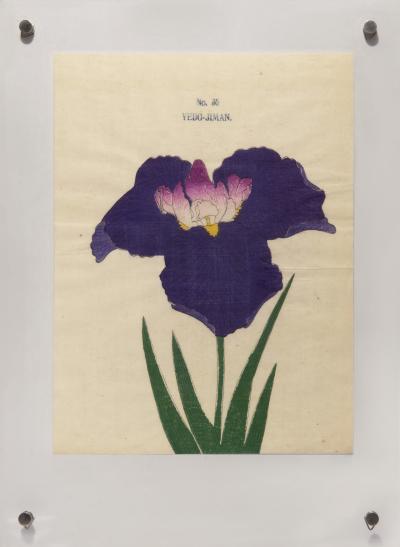- FINE ART
-
FURNITURE + LIGHTING
Shop By Category
Shop By Artist
- NEW + CUSTOM
- DECORATIVE ARTS
-
JEWELRY
Shop By Category
Shop By Artist
- INTERIORS
- MAGAZINE
Listings / Fine Art / Prints / Figurative
Showrooms
A Set of Four Bust Portraits of Beauties - Jidai Kagami (Mirror of the Ages).
Sold
Sold
-
Tear Sheet Print
- Save
- BoardAdd to Board
-
-
Description
A Set of four oban tate-e woodblock prints of okubi-e (bust portraits) of beauties, titled Jidai kagami (Mirror of the Ages), documenting the fashions of former times (from the Keicho to the Meiji era) in chronological order, each sheet with a beautiful woman in sumptuous costume depicted at the lower section and a rectangular panel at the top which makes a reference to the era, some sheets with lacquer and embossed details, published by Matsuki Heikichi, variously dated Meiji 29, 30 and 31 (1896-8), all signed Yoshu Chikanobu. Each sheet approx. 36 x 23.7 cm (14 1/8 x 9 3/8 in), framed and glazed.
Toyohara Chikanobu (1838–1912), better known to his contemporaries as Yōshū Chikanobu, was one of the most successful woodblock print artists of Japan's Meiji period. He lived at a time when Japan saw the reinstatement of the emperor as ruler and underwent rapid westernization. He worked both with traditional subjects, such as actors, courtesans, scenes of famous sites, beautiful women, and with topical subjects, such as the Satsuma Rebellion (1877) and the Sino-Japanese War (1894-1895). Chikanobu used the flat planes and decorative patterning of the ukiyo-e tradition to striking effect, adding brilliant colours, especially reds, purples, and blues to his compositions.
More precisely, Ukiyo-e, or ukiyo-ye (in Japanese: "pictures of the floating world"), is a genre of woodblock prints and paintings that flourished in Japan from the 17th through 19th centuries. It was aimed at the prosperous merchant class in the urbanizing Edo period (1603–1867). Amongst the popular themes were depictions of beautiful women, as is the case here with these okubi-e prints (i.e. bust portraits); kabuki actors and sumo wrestlers; scenes from history and folk tales; travel scenes and landscapes; flora and fauna; and erotica.
One of Chikanobu’s best series, A Mirror of the Ages shows women by fashion and hair style throughout history. Despite a sense of longing for the past, these prints are unmistakably modern and of their time. Each print depicts a beauty from a certain period in the lower part and customs at that time, in grisaille, in the upper part - a way to tell viewers about the latest fashion and historical backgroud at that time. The quality of printing is outstanding, especially in Chikanobu’s use of white for the rendering of the powdered faces. Indeed, Chikanobu was known as a master of bijinga (images of beautiful women), and for illustrating changes in women's fashion, including both traditional and Western clothing. For example, in the Mirror of Ages, the hair styles of the Tenmei era (1781-1789) are distinguished from those of the Keiō era (1865-1867).
To create a woodblock print, artists like Chikanobu first designed the image on paper and then transferred it to a thin, partly transparent paper. Following the lines on the paper, now pasted to a wooden block usually of cherry wood, the carver used to chisel and cut to create the original in negative—with the lines and areas to be coloured raised in relief. Ink was then applied to the surface of the woodblock. Rubbing a round pad over the back of a piece of paper laid over the top of the inked board eventually made the print.
Chikanobu was able to produce such bright and colourful prints because in 1765, new technology had made it possible to produce single-sheet prints in a whole range of colours. Polychrome prints were made using a separate carved block for each color, which could number up to twenty. To print with precision using numerous blocks on a single paper sheet, a system of placing two cuts on the edge of each block to serve as alignment guides was employed. Paper made from the inner bark of mulberry trees was favored, as it was strong enough to withstand numerous rubbings on the various woodblocks and sufficiently absorbent to take up the ink and pigments. Reproductions, sometimes numbering in the thousands, could be made until the carvings on the woodblocks became worn.
The present set of prints follows the oban format, which is the most common print size. It corresponds to half a large hosho sheet, in other words about 24x37 cm. The word “tate-e” refers to the alignment of the print; in this case, a vertically aligned print. - More Information
-
Dimensions
W. 9.33 in; H. 14.17 in; W. 23.7 cm; H. 36 cm;
Message from Seller:
Shapero Gallery Located in the heart of Mayfair, London, Shapero Gallery specializes in prints and original works on paper, ranging from antique prints to modern pochoir plates and photography. For inquiries, contact us at +44.207.493.0876 or gallery@shapero.com.
Sold
Sign In To View Price
close
You must Sign In to your account to view the price. If you don’t have an account, please Create an Account below.
More Listings from Shapero Gallery View all 652 listings
No Listings to show.
- [RUSSIAN MILITARY UNIFORMS]. by KARL KARLOVICH PIRATSKIY
- Suite Catalana, plate 4 by ANTONI TAPIES
- A Pair of Melons
- Views of South Africa. by W.L.CANEY
- Flamingoes at Sunrise, Lake Nukuru, Kenya. by ROGER HOOPER
- Japanese Iris - SHU-FU-RAKU
- Dar-es-Salaam, Tanzania. by C. VINCENTI
- Mergus Serrator [Merganser]
- Certificate by James Rosenquist
- Collection des Fleurs et des Fruits: a Set of Five Floral Designs.
- The Temple of El-Karnak, south east. by FRANCIS FRITH
- Japanese Iris - YEDO-JIMAN
- Japanese Iris - CHO-HIYEN
- Suite of Nine Prints by ROBERT RAUSCHENBERG
- [RUSSIAN MILITARY UNIFORMS]. by KARL KARLOVICH PIRATSKIY
- Suite Catalana, plate 4 by ANTONI TAPIES
- A Pair of Melons
- Views of South Africa. by W.L.CANEY
- Flamingoes at Sunrise, Lake Nukuru, Kenya. by ROGER HOOPER
- Japanese Iris - SHU-FU-RAKU
- Dar-es-Salaam, Tanzania. by C. VINCENTI
- Mergus Serrator [Merganser]
- Certificate by James Rosenquist
- Collection des Fleurs et des Fruits: a Set of Five Floral Designs.
- The Temple of El-Karnak, south east. by FRANCIS FRITH
- Japanese Iris - YEDO-JIMAN

















